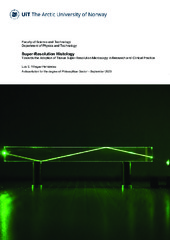Super-resolution histology
Permanent link
https://hdl.handle.net/10037/31846Date
2023-12-05Type
Doctoral thesisDoktorgradsavhandling
Abstract
Super-resolution optical microscopy (SRM) holds great promise for the advancement of life sciences, unlocking the secrets of the minute machinery composing living organisms. While broadly accepted in cell biology, the existing SRM methods haven’t effectively breached relevant fields such as histological practice, mainly due to the complexity, elevated costs, limited throughput, and incompatibility with conventional sample preparation workflows posed by these novel imaging methods.
This thesis contributes to the adoption of super-resolution histology both in research and clinical settings by shedding light on the practical aspects of tissue super-resolution. Here, two SRM microscopy platforms with good prospects for high throughput imaging of tissues are evaluated: a) a state-of-the-art commercially-available DeltaVision OMX V4 Blaze microscope, supporting multi-color 3D structured illumination microscopy (3D-SIM); and b) a custom-built photonic chip-based microscope, offering a series of high-contrast waveguide-based microscopy modalities including total internal reflection fluorescence (chip-TIRF), and SRM imaging via single-molecule localization microscopy (on-chip SMLM), fluorescence fluctuations-based super-resolution microscopy (on-chip FF-SRM), and correlative light-electron microscopy (on-chip CLEM). Accordingly, to evaluate the SRM imaging capabilities of such microscopy platforms, two distinct histological methods are explored, namely 1) the Tokuyasu cryopreservation; and 2) the formalin-fixation paraffin-embedding (FFPE). These include tissue sections of human and animal origin.
The research results are presented in three original scientific papers. Paper I deals with the implementation of 3D-SIM on human placental sections. Particularly, the use of the 3D-SIM method allowed for a high-contrast visualization of individual microvilli on cryo-preserved sections, a structural feature not visible in conventional optical microscopy methods. This, to our knowledge, is the first observation of this kind using optical microscopy. A major limitation of the explored 3D-SIM configuration, however, was the limited field-of-view (FOV) supported by the OMX microscope. In Paper II, a photonic chip-based microscopy approach for the screening of Tokuyasu tissue sections is proposed, allowing for high-contrast large FOV screening of histological samples through diverse on-chip imaging modalities including TIRF, SLML, FF-SRM, and CLEM. This work is, to our understanding, the first experimental demonstration of chip-based histology. Lastly, continuing with the photonic chip approach, Paper III proposes a novel methodology for super-resolution histology of conventional FFPE sections. Here, the photonic chip not only proved compatible with the standard FFPE preparation protocols but also showed unprecedented optical sectioning capabilities that, together with its multimode interference illumination pattern, enabled superior observation of clinically-relevant samples via the on-chip FF-SRM method.
The practical challenges of both imaging acquisition and sample preparation are thoughtfully discussed throughout this dissertation, providing a holistic perspective for their practical implementations. Overall, the adoption of SRM methods in histology will require further advancements in aspects such as sample preparation, imaging acquisition, storage, and data post-processing, directed towards their integration into existing laboratory routines, enabling a simple, repeatable, and low-cost operational workflow.
Has part(s)
Paper I: Villegas-Hernández, L.E., Nystad, M., Ströhl, F., Basnet, P., Acharya, G. & Ahluwalia, B.S. (2020). Visualizing ultrastructural details of placental tissue with superresolution structured illumination microscopy. Placenta, 97, 42-45. Also available in Munin at https://hdl.handle.net/10037/20990.
Paper II: Villegas-Hernández, L.E., Dubey, V., Nystad, M., Tinguely, J.C., Coucheron, D.A., Dullo, F.T., … Ahluwalia, B.S. (2022). Chip-based multimodal super-resolution microscopy for histological investigations of cryopreserved tissue sections. Light: Science & Applications, 11, 43. Also available in Munin at https://hdl.handle.net/10037/26662.
Paper III: Villegas-Hernández, L.E., Dubey, V.K., Mao, H., Pradhan, M., Tinguely, J.C., Hansen, D.H., … Ahluwalia, B.S. Super-resolution histology of paraffin-embedded samples via photonic chip-based microscopy. (Manuscript). Also available on bioRxiv at https://doi.org/10.1101/2023.06.14.544765.
Publisher
UiT Norges arktiske universitetUiT The Arctic University of Norway
Metadata
Show full item recordCollections
The following license file are associated with this item:


 English
English norsk
norsk
